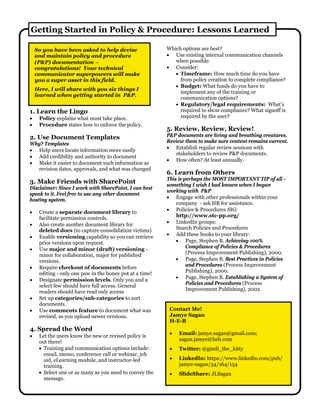Getting Started in Policies and Procedures: Cheat Sheet
- 1. Getting Started in Policy & Procedure: Lessons Learned Contact Me! Jamye Sagan H-E-B ’éĘ’ĆĀ Email: jamye.sagan@gmail.com; sagan.jamye@heb.com ’éĘ’ĆĀ Twitter: @gimli_the_kitty ’éĘ’ĆĀ LinkedIn: https://www.linkedin.com/pub/ jamye-sagan/34/164/154 ’éĘ’ĆĀ ║▌║▌▀ŻShare: JLSagan 1. Learn the Lingo ’éĘ’ĆĀ Policy explains what must take place. ’éĘ’ĆĀ Procedure states how to enforce the policy. 2. Use Document Templates Why? Templates ’éĘ’ĆĀ Help users locate information more easily ’éĘ’ĆĀ Add credibility and authority to document ’éĘ’ĆĀ Make it easier to document such information as revision dates, approvals, and what was changed 3. Make Friends with SharePoint Disclaimer: Since I work with SharePoint, I can best speak to it. Feel free to use any other document hosting system. ’éĘ’ĆĀ Create a separate document library to facilitate permission controls. ’éĘ’ĆĀ Also create another document library for deleted docs (to capture consolidation victims) ’éĘ’ĆĀ Enable versioning capability so you can retrieve prior versions upon request. ’éĘ’ĆĀ Use major and minor (draft) versioning - minor for collaboration, major for published versions. ’éĘ’ĆĀ Require checkout of documents before editing - only one paw in the honey pot at a time! ’éĘ’ĆĀ Designate permission levels. Only you and a select few should have full access. General readers should have read only access ’éĘ’ĆĀ Set up categories/sub-categories to sort documents. ’éĘ’ĆĀ Use comments feature to document what was revised, as you upload newer versions. 4. Spread the Word ’éĘ’ĆĀ Let the users know the new or revised policy is out there! ’éĘ’ĆĀ Training and communication options include: email, memo, conference call or webinar, job aid, eLearning module, and instructor-led training. ’éĘ’ĆĀ Select one or as many as you need to convey the message. So you have been asked to help devise and maintain policy and procedure (P&P) documentation ’ĆŁ congratulations! Your technical communicator superpowers will make you a super asset in this field. Here, I will share with you six things I learned when getting started in P&P. Which options are best? ’éĘ’ĆĀ Use existing internal communication channels when possible. ’éĘ’ĆĀ Consider: ’éĘ’ĆĀ Timeframe: How much time do you have from policy creation to complete compliance? ’éĘ’ĆĀ Budget: What funds do you have to implement any of the training or communication options? ’éĘ’ĆĀ Regulatory/legal requirements: WhatŌĆÖs required to show compliance? What signoff is required by the user? 5. Review, Review, Review! P&P documents are living and breathing creatures. Review them to make sure content remains current. ’éĘ’ĆĀ Establish regular review sessions with stakeholders to review P&P documents. ’éĘ’ĆĀ How often? At least annually. 6. Learn from Others This is perhaps the MOST IMPORTANT TIP of all - something I wish I had known when I began working with P&P ’éĘ’ĆĀ Engage with other professionals within your company - ask HR for assistance. ’éĘ’ĆĀ Policies & Procedures SIG: http://www.stc-pp.org/ ’éĘ’ĆĀ LinkedIn groups: Search Policies and Procedures ’éĘ’ĆĀ Add these books to your library: ’éĘ’ĆĀ Page, Stephen B. Achieving 100% Compliance of Policies & Procedures (Process Improvement Publishing), 2000. ’éĘ’ĆĀ Page, Stephen B. Best Practices in Policies and Procedures (Process Improvement Publishing), 2000. ’éĘ’ĆĀ Page, Stephen B. Establishing a System of Policies and Procedures (Process Improvement Publishing), 2002.


